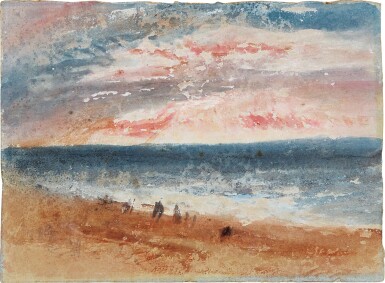Master Works on Paper from Five Centuries
Master Works on Paper from Five Centuries

Joseph Mallord William Turner, R.A.
Figures on a beach at Margate, Kent
Auction Closed
July 6, 10:38 AM GMT
Estimate
50,000 - 80,000 GBP
Lot Details
Description
Joseph Mallord William Turner, R.A.
London 1775 - 1851
Figures on a beach at Margate, Kent
Watercolour and bodycolour, heightened with touches of black chalk and pencil on blue paper
140 by 191 mm
John Pound, her son;
William Dickinson of Beausite House, Camberley (1885-1968), by circa 1950,
by descent to the present owners
In this plein-air watercolour, which is full of energy and vibrancy, Turner looks out to sea towards a spectacular sky which is streaked with blues, greys, crimsons and pinks. On the beach in the foreground Turner suggests figures in pencil and old mooring stakes in black, these ghostly forms standing out dramatically against the mustard coloured sands.
The work's palette suggests that it dates to the 1840s, and it can be related to the group of rapidly executed and highly atmospheric watercolours that largely depict marine or shore subjects, listed in Andrew Wilton’s catalogue raisonné as numbers 1382-1397.1
Turner is almost certainly depicting here the beach at Margate, a place for which he had a great affection. He first visited the fashionable seaside town at the age of eleven and later in his life, particularly during the 1830s and 1840s, he regularly used it as a retreat from London. While there, he lodged with Sophia Caroline Booth who ran a boarding house on the sea front. The pair became very close and in 1846 Turner invited her to live with him in London, where she carried out the duties of devoted housekeeper.
The present lot is painted on a blue paper made by Bally, Ellen and Steart, a firm of paper makers that Turner particularly favoured from the 1820s onwards. Peter Bower, the distinguished paper historian, perhaps put it best when he wrote that Turner understood ‘the scale of Steart’s paper, he knew what size marks were appropriate to his particular ends…, and with what degree of wetness or dryness the colours could be applied. Steart’s paper gave Turner complete control, and it allowed him to make marks that ‘dance’ on the surface.’2
Although rapidly executed studies of nature such as the present sheet were ignored by many of Turner’s contemporaries, it is works such as these that have contributed to his international reputation as a ground-breaking artist, who looked forward to the future.
We are grateful to Andrew Wilton and Peter Bower for their help when cataloguing this work.
1. A. Wilton, The Life and Work of J.M.W. Turner, Fribourg 1979, pp. 466-467, nos. 1382-1897
2. P. Bower, Turner's Later Papers: A Study of the Manufacture, Selection and Use of His Drawing Papers, 1820-1851, London 1999, pp. 88-99
